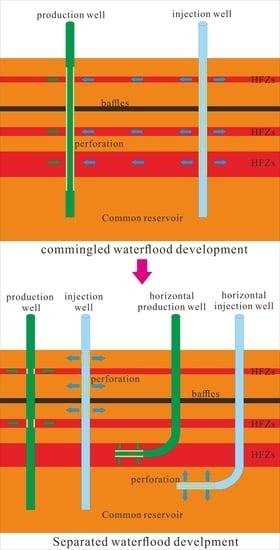Characteristics of High Flow Zones and a Balanced Development Strategy of a Thick Bioclastic Limestone Reservoir in the Mishrif Formation in X Oilfield, Iraq
Abstract
:1. Introduction
2. Geological Setting
3. Materials and Methods
4. Results
4.1. Geological Factors of Unbalanced Development
4.2. HFZs Characterization
4.2.1. Permeability and Thickness
4.2.2. Types and Pores
4.2.3. Microstructure
4.2.4. Distribution
4.3. Balanced Development Strategy
4.3.1. Reservoir Connectivity
4.3.2. Separated Development
4.3.3. Differentiated Well Pattern
4.3.4. Reasonable Utilization and Avoidance of HFZs
5. Discussion
6. Conclusions and Implementation Effects
- (1)
- The Mishrif Formation is intensely heterogeneous and the HFZs are the main geological factors resulting in unbalanced production. Separate development would be a useful method to enhance the recovery ratio. Deploy reasonable injection—production well patterns according to the scale and distribution of reservoirs in different development units. Reasonable utilization and avoidance HFZs, deploy injection wells in tight or poor reservoirs to evenly displace oil through moderate water injection mode.
- (2)
- Reservoir numerical simulation shows that the new strategy has a longer plateau production period compared with the original development plan. The recovery ratio is nearly 30% within the specified period, and the water cut is 1.1% lower than the original plan. Under the same recovery ratio, nearly 400 fewer new wells can be drilled compared with the original plan, saving a lot of investment costs.
- (3)
- According to the new development strategy, a pilot area has been deployed in the northern part of the study area. At present, more than 40 wells have been completed and have been put into full production. The production shows that the simulation is in good agreement with the actual production, and the coincidence rate between the actual production and the predicted production is 91.7%, indicating that the new development strategy can guide the adjusted development of the Mishrif Formation.
Author Contributions
Funding
Data Availability Statement
Conflicts of Interest
References
- Aqrawi, A.A.M.; Gof, J.C.; Horbury, A.D.; Sadooni, F. The Petroleum Geology of Iraq; Scientific Press: Bucks, UK, 2010. [Google Scholar]
- Li, B.; Najeh, H.; Lantz, J.; Rampurawala, M.A.; Gok, I.M.; Al-Khabbaz, M. Detecting Thief Zones in Carbonate Reservoirs by Integrating Borehole Images With Dynamic Measurements: Case Study from the Mauddud Reservoir, North Kuwait. SPE Reserv. Eval. Eng. 2010, 13, 193–202. [Google Scholar] [CrossRef]
- Li, F.; Song, X.; Guo, R.; Liu, L.; Song, S. Characteristics and genesis of interlayers of thick bioclastic limestone reservoirs: A case study of Cretaceous Mishrif Formation, M oilfield in the Middle East. Acta Pet. Sin. 2021, 42, 853–864. [Google Scholar]
- Han, H.; Tian, Z.; Xu, Z.; Yao, Z.; Yi, J.; Li, F. Genesis and distribution of high permeable streaks of the Cretaceous bioclastic limesrone reservoir in W Oilfield, Iraq. Mar. Orig. Petreoleum Geol. 2022, 27, 261–270. Available online: http://kns.cnki.net/kcms/de-tail/33.1328.P.20220402.1257.002.html (accessed on 6 April 2022).
- Shen, A.; Zheng, Z.; Chen, Y.; Ni, X. Characteristics, origin and distribution of dolomite reservoirs in Lower-Middle Cambrian, Tarim Basin, NW China. Pet. Explor. Dev. 2015, 42, 545–554. [Google Scholar] [CrossRef]
- Li, R.; Chen, Q.; Deng, H.; Fu, M.; Hu, L.; Xie, X.; Zhang, L.; Guo, X.; Fan, H.; Xiang, Z. Quantitative evaluation of the carbonate reservoir heterogeneity based on production dynamic data: A case study from Cretaceous Mishrif formation in Halfaya oilfield, Iraq. J. Pet. Sci. Eng. 2021, 206, 109007. [Google Scholar] [CrossRef]
- Chafeet, H.A.; Raheem, M.K.; Dahham, N.A. Diagenesis processes impact on the carbonate Mishrif quality in Ratawi oilfield, southern Iraq. Model. Earth Syst. Environ. 2020, 6, 2609–2622. [Google Scholar] [CrossRef]
- Chen, P.; Guo, L.; Li, C.; Tong, Y. Karstification characteristics of the Cenomanian-Turonian Mishrif Formation in the Missan Oil Fields, southeastern Iraq, and their effects on reservoirs. Front. Earth Sci. 2022, 16, 435–445. [Google Scholar] [CrossRef]
- Xu, J.; Deng, Y.; Fu, M.; Guo, R.; Chen, P.; Duan, G.; Ma, R. The Nonuniform Distribution of Stylolite in Bioclastic Limestones and Its Influence on Reservoir Petro-Physical Properties—A Case Study of the Mishrif Formation from the Ah Oilfield. Energies 2022, 15, 3032. [Google Scholar] [CrossRef]
- Mohammed, A.; Dhaidan, M.; Al-Hazaa, S.H.; Farouk, S.; Al-Kahtany, K. Reservoir characterization of the upper Turonian—Lower Coniacian Khasib formation, South Iraq: Implications from electrofacies analysis and a sequence stratigraphic framework. J. Afr. Earth Sci. 2022, 186, 104431. [Google Scholar] [CrossRef]
- Wang, H.; Shi, K.; Ma, Y.; Liu, B.; Song, X.; Ge, Y.; Liu, H.; Hoffmann, R.; Immenhauser, A. Control of depositional and diagenetic processes on the reservoir properties of the Mishrif Formation in the AD oilfield, Central Mesopotamian Basin, Iraq. Mar. Pet. Geol. 2021, 132, 105202. [Google Scholar] [CrossRef]
- Al-Musawi, F.A.; Idan, R.M.; Salih, A.L.M. Reservoir characterization, Facies distribution, and sequence stratigraphy of Mishrif Formation in a selected oilfield, South of Iraq. J. Phys. Conf. Ser. 2020, 1660, 012073. [Google Scholar] [CrossRef]
- Cantrell, D.; Shah, R.; Ou, J.; Xu, C.; Phillips, C.; Li, X.; Hu, T. Depositional and diagenetic controls on reservoir quality: Example from the upper Cretaceous Mishrif Formation of Iraq. Mar. Pet. Geol. 2020, 118, 104415. [Google Scholar] [CrossRef]
- Liu, H.; Tian, Z.; Liu, B.; Guo, R.; Yang, D.; Yu, Y.; Shi, K. Pore types, origins and control on reservoir heterogeneity of carbonate rocks in Middle Cretaceous Mishrif Formation of the West Qurna oilfield, Iraq. J. Pet. Sci. Eng. 2018, 171, 1338–1349. [Google Scholar] [CrossRef]
- Yao, Z.; Liu, H.; Tian, Z.; Guo, R.; Yang, D. Characteristics and Main Controlling Factors of Carbonate Reservoir of the Middle Cretaceous Mishrif Formation in the West Qurna Oilfield, Iraq. Mar. Orig. Pet. Geology. 2018, 23, 59–69. [Google Scholar]
- Sun, X.; Guo, R.; Tian, Z.; Deng, Y.; Han, H.; Yi, Y.; Xu, Z.; Chen, L.; Huang, T. Classification and main controlling factors of porous carbonate reservoir: A case study from Mishrif Formation, West Qurna Oilfield, Iraq. Geol. Sci. Technol. Inf. 2017, 36, 150–155. [Google Scholar]
- Wang, R.; Wang, Z.; Osumanu, A.; Zhang, G.; Li, B.; Lu, Y. Grid density overlapping hierarchical algorithm for clustering of carbonate reservoir rock types: A case from Mishrif Formation of West Qurna-1 oilfield, Iraq. J. Pet. Sci. Eng. 2019, 182, 106209. [Google Scholar] [CrossRef]
- Fang, X.; Feng, H.; Wu, H.; Wang, Y. Study on a quantitative rock type discrimination model for porous carbonate reservoirs: A case by the Late Cretaceous Mishrif Formation in the West Qurna oilfield, Iraq. Prog. Geophys. 2021, 37, 1013–2023. [Google Scholar]
- Al-Dujaili, A.N.; Shabani, M.; Al-Jawad, M.S. Characterization of flow units, rock and pore types for Mishrif Reservoir in West Qurna oilfield, Southern Iraq by using lithofacies data. J. Pet. Explor. Prod. Technol. 2021, 11, 4005–4018. [Google Scholar] [CrossRef]
- Liu, H.; Tian, Z.; Liu, B.; Guo, R.; Shi, K.; Ye, Y. Classification and prediction of giant thick strongly heterogeneous carbonate reservoirs in the Middle East area: A case study of Mid-Cretaceous Mishrif Formation in the W oilfield of Iraq. Acta Pet. Sin. 2019, 40, 677–691. [Google Scholar]
- Deng, Y.; Guo, R.; Tian, Z.; Tan, W.; Yi, Y.; Xu, Z.; Xiao, C.; Cao, X.; Chen, L. Geologic features and genesis of the barriers and intercalations in carbonates: A case study of the Cretaceous Mishrif Formation, West Qurna oil field, Iraq. Pet. Explor. Dev. 2016, 43, 149–157. [Google Scholar] [CrossRef]
- Hussain, S.A.; Al-Obaidi, M.; Khwedim, K.; Ahmad, K. Facies Architecture, Diagenesis and Paleoceanography of Mishrif (Late Cretaceous) in Selected Wells of West Qurna Oil Field, Southern Iraq. J. Phys. Conf. Ser. 2020, 1664, 012137. [Google Scholar] [CrossRef]
- Farouk, S.; Ahmad, F.; Powell, J.H. Cenomanian-Turonian stable isotope signatures and depositional sequences in northeast Egypt and central Jordan. J. Asian Earth Sci. 2017, 134, 207–230. [Google Scholar] [CrossRef]
- Mahdi, T.A.; Aqrawi, A.A.M. Sequence Stratigraphic Analysis of the Mid-Cretaceous Mishrif Formation, Southern Mesopotamian Basin, Iraq. J. Pet. Geol. 2014, 37, 287–312. [Google Scholar] [CrossRef]
- Mahdi, T.A.; Aqrawi, A.A.M. Role of facies diversity and cyclicity on the reservoir quality of the mid-Cretaceous Mishrif Formation in the southern Mesopotamian Basin, Iraq. Geol. Soc. Lond. Spéc. Publ. 2017, 435, 85–105. [Google Scholar] [CrossRef]
- Rafiei, Y.; Motie, M. Improved reservoir characterization by employing hydraulic flow unit classification in one of Iranian carbonate reservoirs. Adv. Geo-Energy Res. 2019, 3, 277–286. [Google Scholar] [CrossRef]
- Liu, H.; Kaibo, S.; Bo, L.; Song, X.; Deng, L.; Guo, R.; Tian, Z.; Li, Y.; Deng, Y.; Wang, G. The characteristics and origins of thief zones in the cretaceous limestone reservoirs of central and southern Mesopotamian Basin. J. Pet. Sci. Eng. 2021, 201, 108395. [Google Scholar] [CrossRef]
- Meyer, F.O.; Price, R.C.; Al-Raimi, S.M. Stratigraphic and Petrophysical Characteristics of Cored Arab-D Super-k Intervals, Hawiyah Area, Ghawar Field, Saudi Arabia. Geoarabia 2000, 5, 355–384. [Google Scholar] [CrossRef]
- Zhang, Q.; Li, Y.; Li, B.; Liu, Z.; Wei, C.; Zhou, J. Identification methods and development strategy study of thief zone in reef-bank carbonate reservoir: A case study of the Mishrif reservoir in Rumaila oilfield. Pet. Geol. Recover. Effic. 2016, 23, 29–34. [Google Scholar]
- Wang, S.; Han, X.; Dong, Y.; Shi, H. Mechanisms of reservoir pore/throat characteristics evolution during long-term water-flooding. Adv. Geo-Energy Res. 2017, 1, 148–157. [Google Scholar] [CrossRef]
- Song, X.; Li, Y. Optimum development options and strategies for water injection development of carbonate reservoirs in the Middle East. Pet. Explor. Dev. 2018, 45, 723–734. [Google Scholar] [CrossRef]
- Lu, X.; Wang, Y.; Yang, D.; Wang, X. Characterization of paleo-karst reservoir and faulted karst reservoir in Tahe Oilfield, Tarim Basin, China. Adv. Geo-Energy Res. 2020, 4, 339–348. [Google Scholar] [CrossRef]
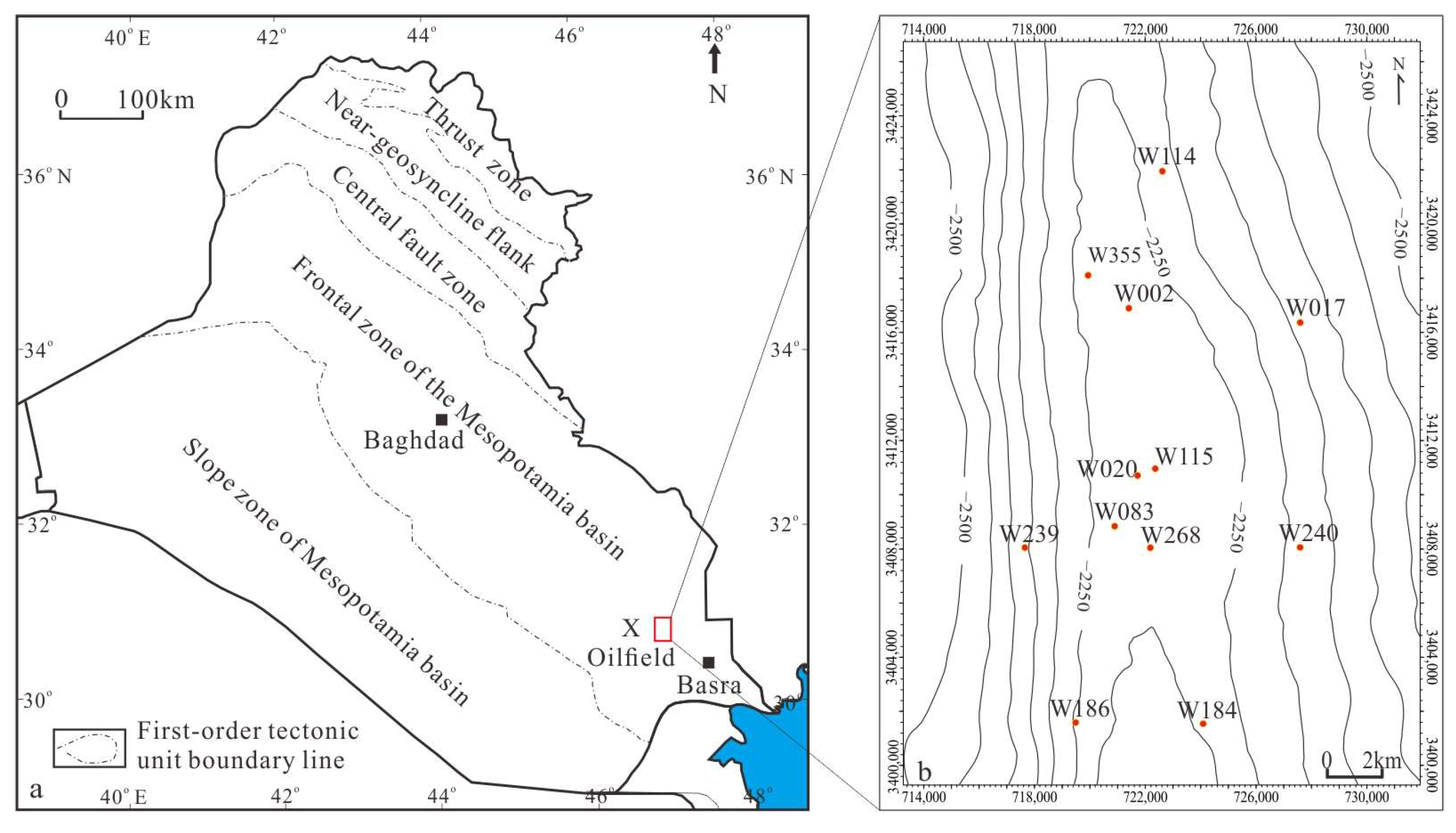


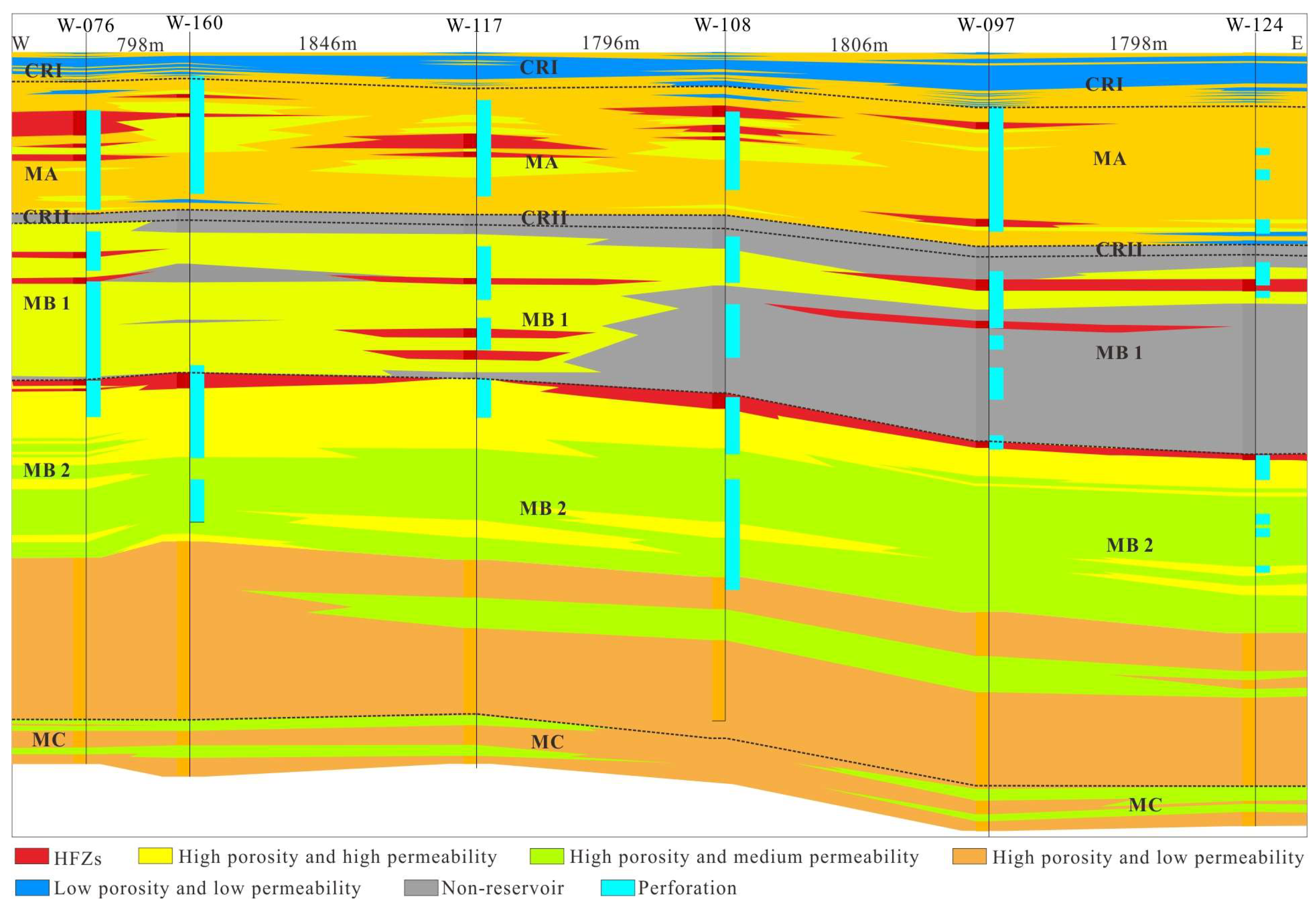
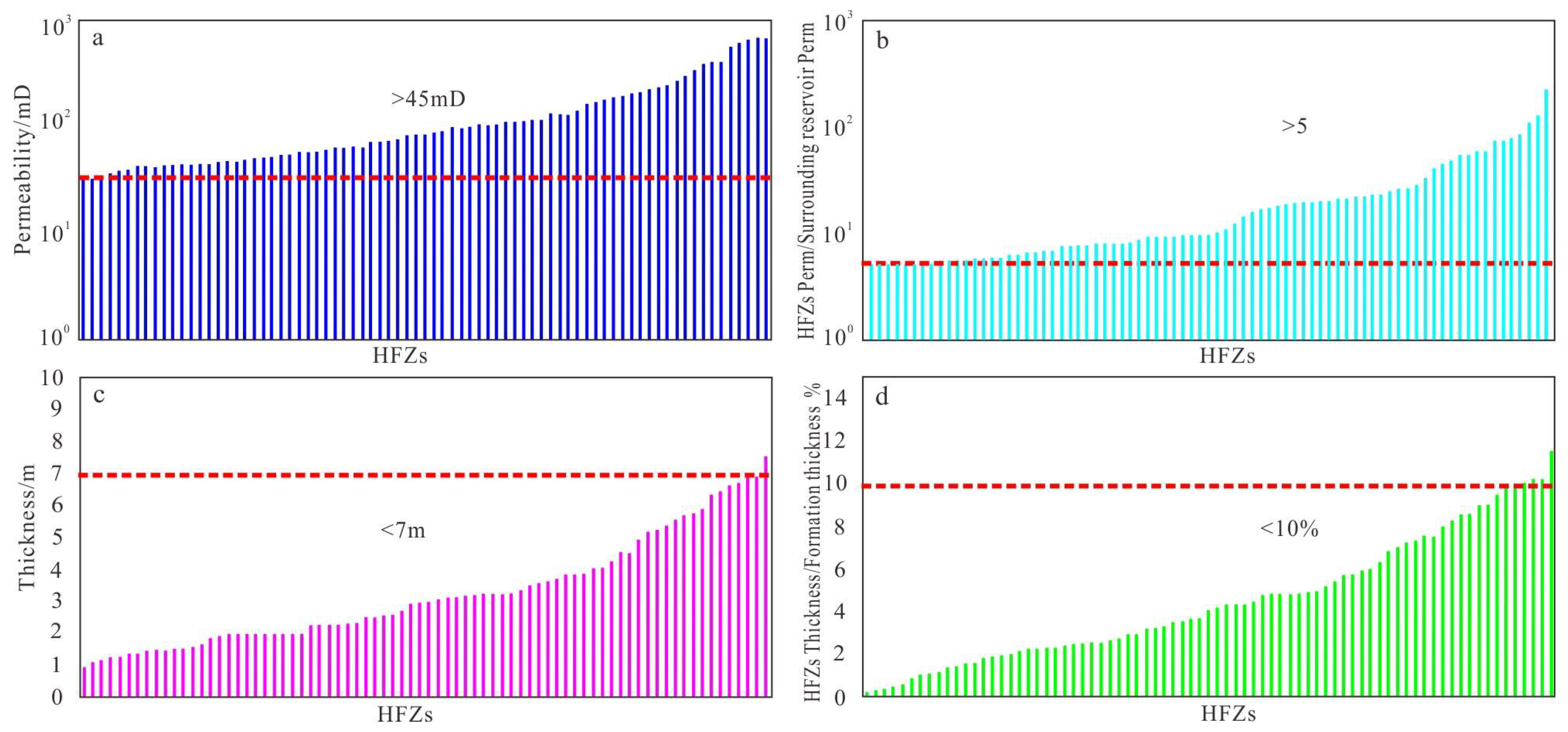


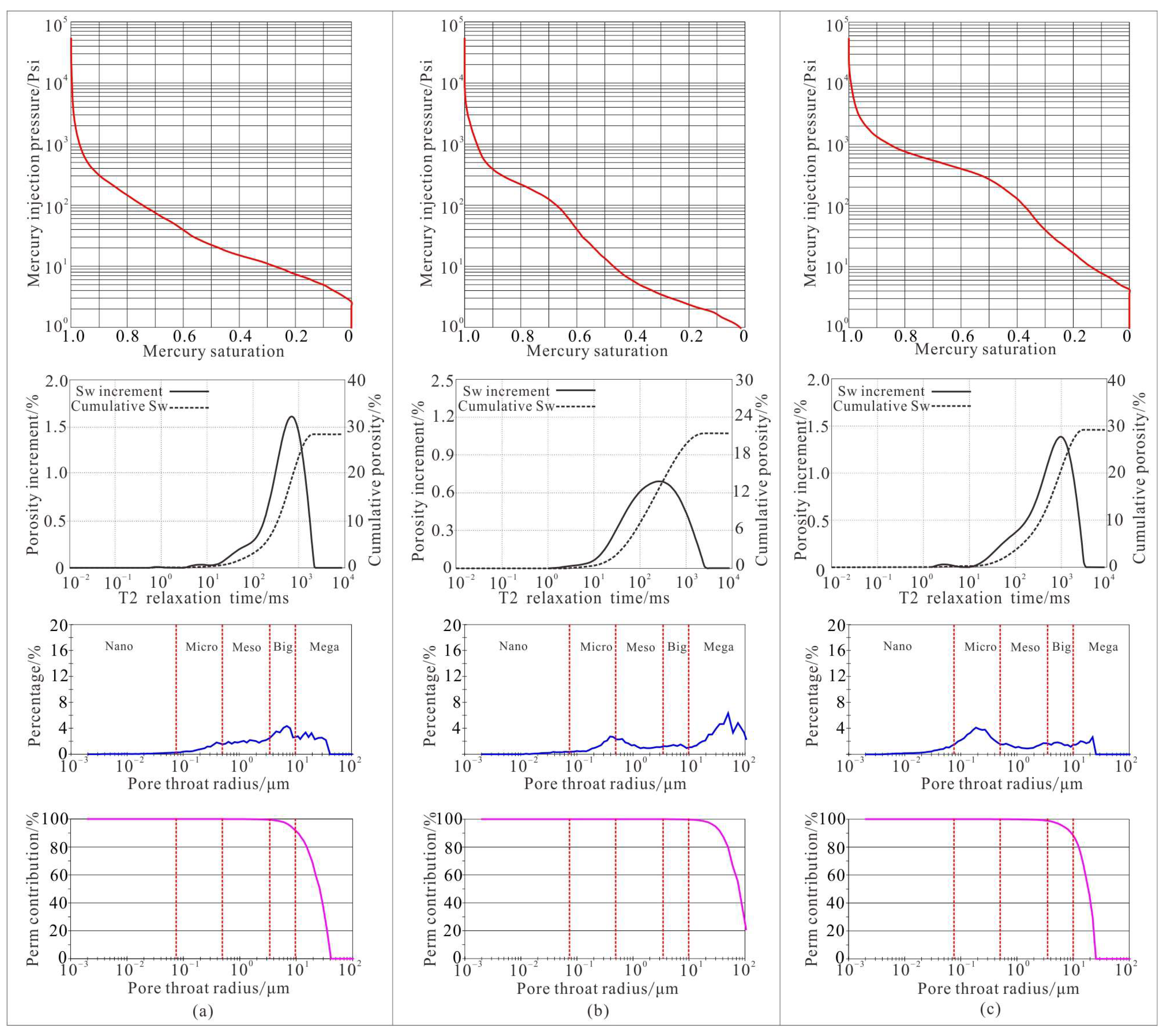
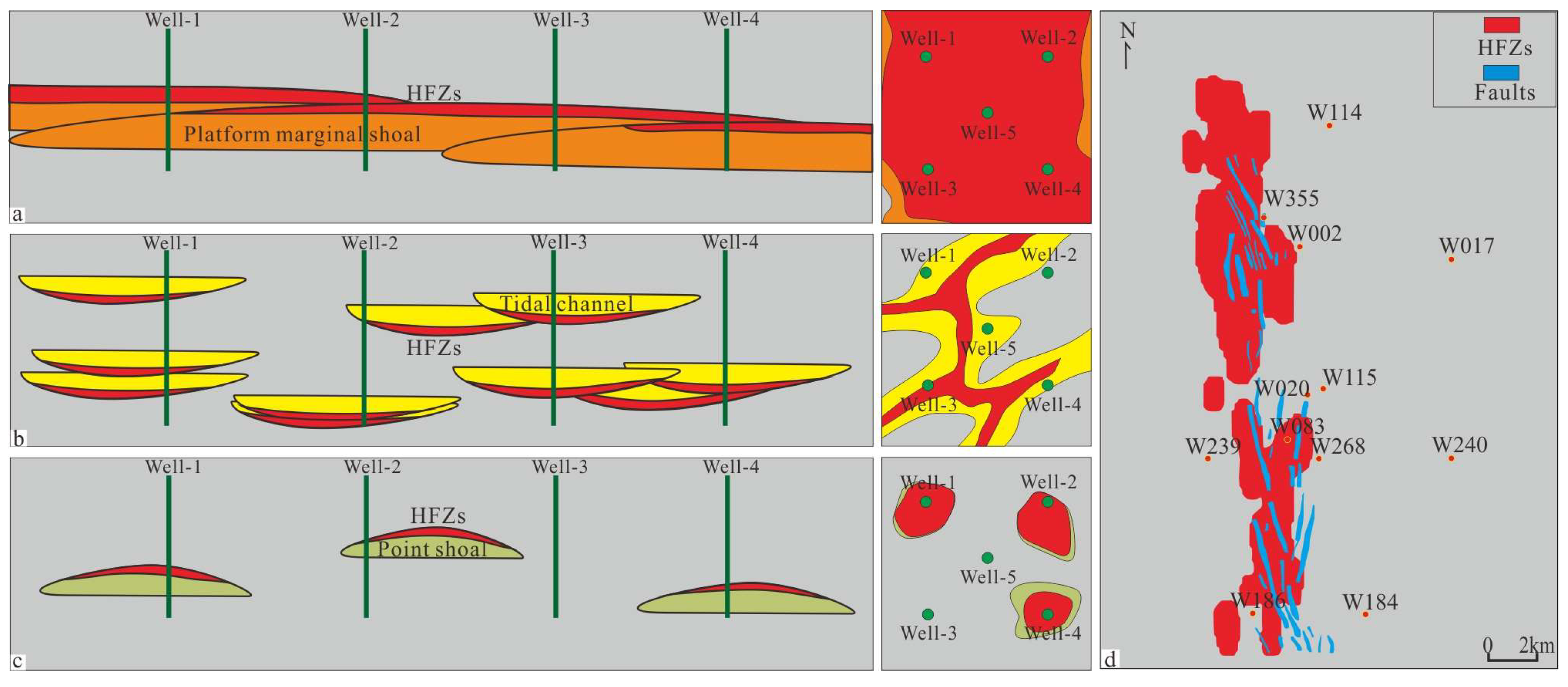
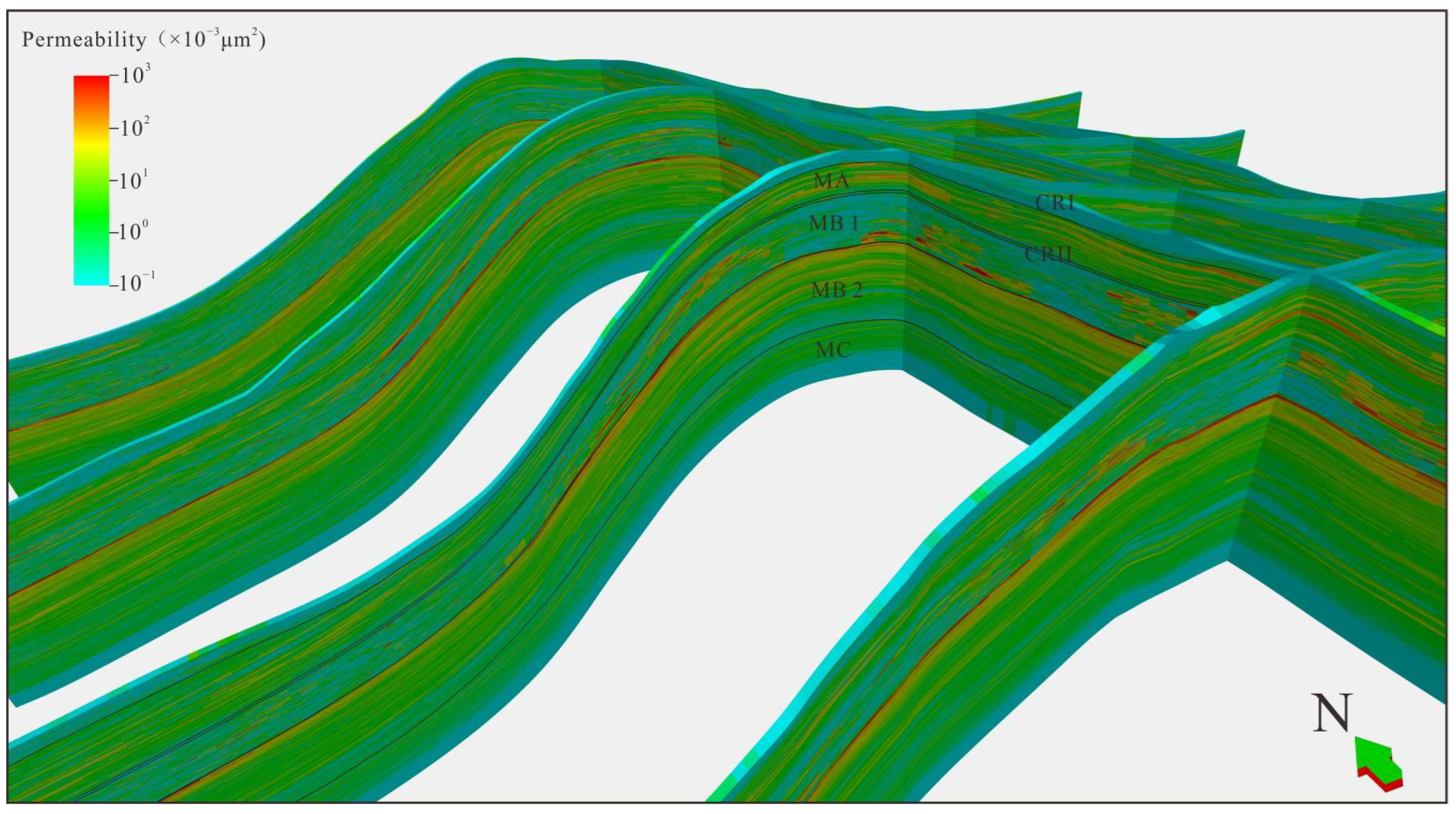
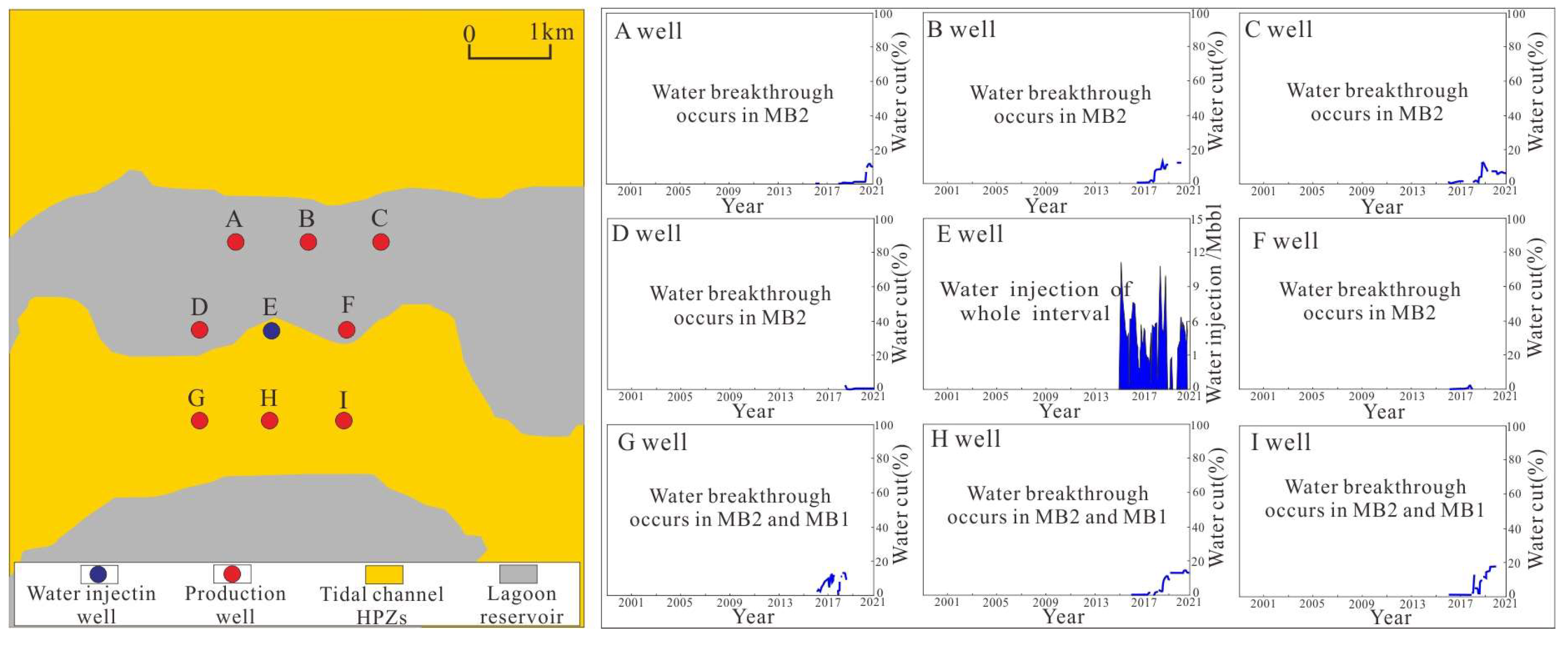
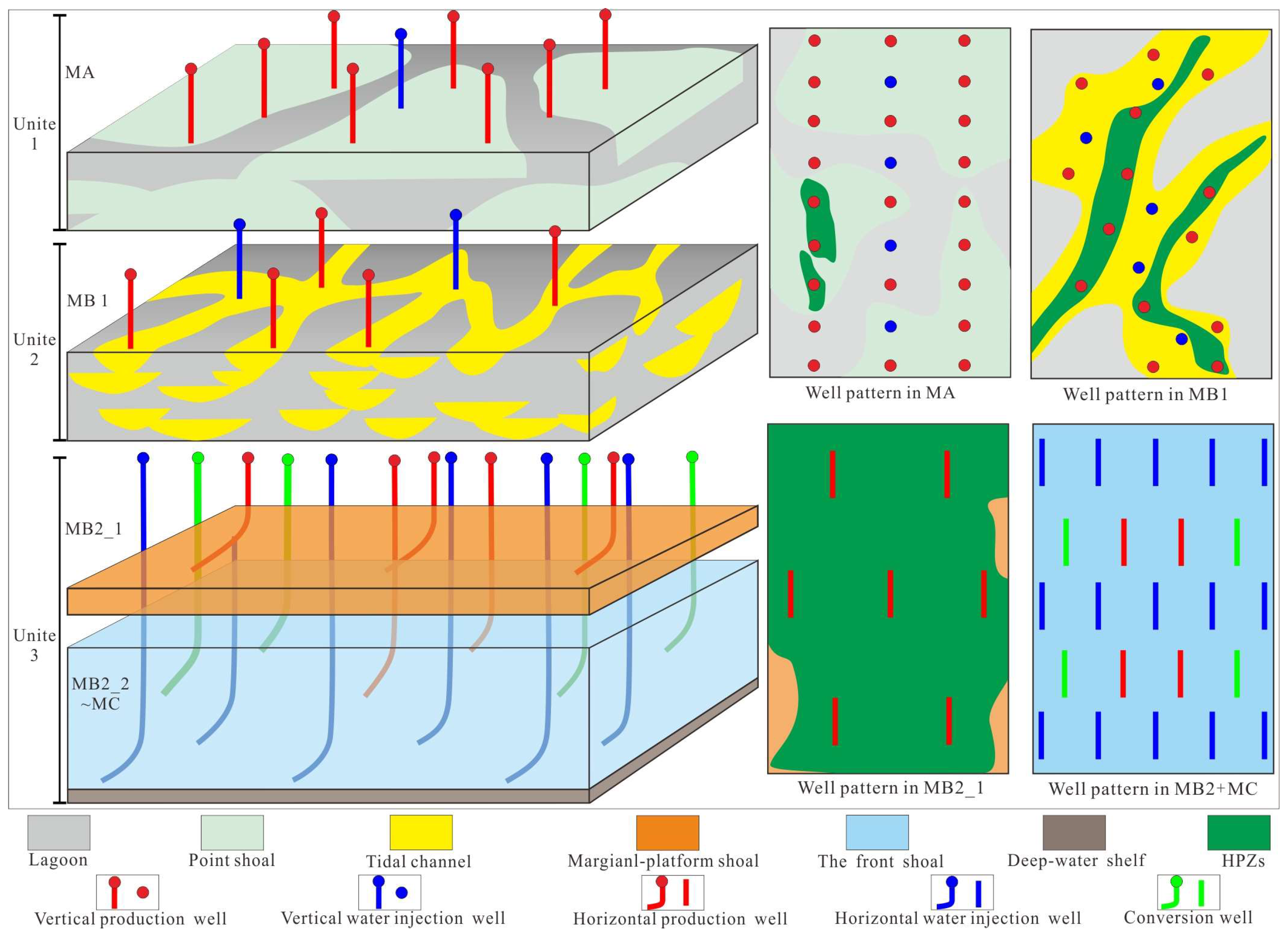
Disclaimer/Publisher’s Note: The statements, opinions and data contained in all publications are solely those of the individual author(s) and contributor(s) and not of MDPI and/or the editor(s). MDPI and/or the editor(s) disclaim responsibility for any injury to people or property resulting from any ideas, methods, instructions or products referred to in the content. |
© 2023 by the authors. Licensee MDPI, Basel, Switzerland. This article is an open access article distributed under the terms and conditions of the Creative Commons Attribution (CC BY) license (https://creativecommons.org/licenses/by/4.0/).
Share and Cite
Li, F.; Li, L.; Chen, J. Characteristics of High Flow Zones and a Balanced Development Strategy of a Thick Bioclastic Limestone Reservoir in the Mishrif Formation in X Oilfield, Iraq. Energies 2023, 16, 1451. https://doi.org/10.3390/en16031451
Li F, Li L, Chen J. Characteristics of High Flow Zones and a Balanced Development Strategy of a Thick Bioclastic Limestone Reservoir in the Mishrif Formation in X Oilfield, Iraq. Energies. 2023; 16(3):1451. https://doi.org/10.3390/en16031451
Chicago/Turabian StyleLi, Fengfeng, Lei Li, and Jiaheng Chen. 2023. "Characteristics of High Flow Zones and a Balanced Development Strategy of a Thick Bioclastic Limestone Reservoir in the Mishrif Formation in X Oilfield, Iraq" Energies 16, no. 3: 1451. https://doi.org/10.3390/en16031451
APA StyleLi, F., Li, L., & Chen, J. (2023). Characteristics of High Flow Zones and a Balanced Development Strategy of a Thick Bioclastic Limestone Reservoir in the Mishrif Formation in X Oilfield, Iraq. Energies, 16(3), 1451. https://doi.org/10.3390/en16031451






